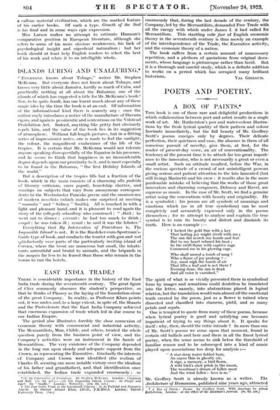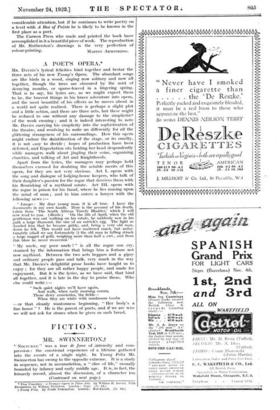POETS AND POETRY.
A BOX OF PAINTS.*
THIS book is one of those rare and delightful productions in which collaboration between poet and artist results in a single work of art. Mr. Rutherston's pen and water-colour illustra- tions by the fresh lyrical quality of their pattern and colour fascinate immediately, but the full beauty of Mr. Geoffrey Scott's poems emerges only by degrees. Their delicate perfection, their quietness and ease, the absence in them of all conscious pursuit of novelty, give them, at first, for the reader of present-day verse, an air of conventionality. The tendency at the present time is to attach far too great import- ance to the innovator, who is not necessarily a great or even a small artist. Such an attitude resulted, before the War, in the curious spectacle of a crowd of not unintelligent persons giving serious and patient attention to the late lamented (but still living) Marinetti and his crew : it results also in the more pardonable mistake of believing that the works of those great innovators and charming composers, Debussy and Ravel, are supreme as music. In the case of Mr. Scott, we find a genuine artist using the conventions with beauty and originality. He is a symbolist : his poems are all symbols of meanings and emotions which (as in all true symbolism) can be most completely and accurately expressed only in the poems themselves ; for to attempt to analyse and explain the true symbol is to ruin its beauty and distort and diminish its truth. Here is an example :—
" I locked the gold Sun with a key That lasting joy might dwell with me ; The sun did scorch my hands and feet But to my heart refused his heat ; So the swift flame with captive rage Consumed me in his glowing cage.
Who shall unseal a tomb of song ? Who a flame of joy prolong ?- Joy, most nigh the touch of air That lifts a leaf and is not there ? Evening done, the sun is dead And all voice is vanished."
The spirit of what is so vividly presented there in symbolical form by images and sensations could doubtless be translated into the letter, namely, into abstractions placed in logical relation, but the translation would ruin almost all-the emotional truth created by the poem, just as a flower is ruined when dissected and classified into stamens, pistil, and so many petals and sepals.
One is tempted to quote from many of these poems, because when lyrical poetry is good and satisfying one becomes impatient of trying to say things about it. It speaks for itself : why, then, should the critic intrude ? In more than one of Mr. Scott's poems we come upon that moment, found in certain old ballads and here and there in all the finest lyrical poetry, when the sense seems to sink below the threshold of familiar reason and to be submerged into a kind of music played upon associations too deep for analysis :—
" A star-deep water folded bare,
An aspen thin in ghostly air, A sign, a memory, a bird flown,
A wild bird's claw prick in the moon, The woodman's dream of fallen snow And the wind fallen : love is so."
Mr. Geoffrey Scott is already known as a writer. The Architecture of Humanism, published nine years ago, attracted
• A Box of Paints: P0e1714. By Geoffrey Scott. With drawings by Albert Butberston, London ; at the Office of the Bookman's Journal. 18s. lid. net.]
considerable attention, but if he continues to write poetry on a level with A Box of Paints he is likely to be known in the first place as a poet.
The Curwen Press who made and printed the book have accomplished in it a beautiful piece of work. The reproduction of Mr. Rutherston's drawings is the very perfection of



















































 Previous page
Previous page